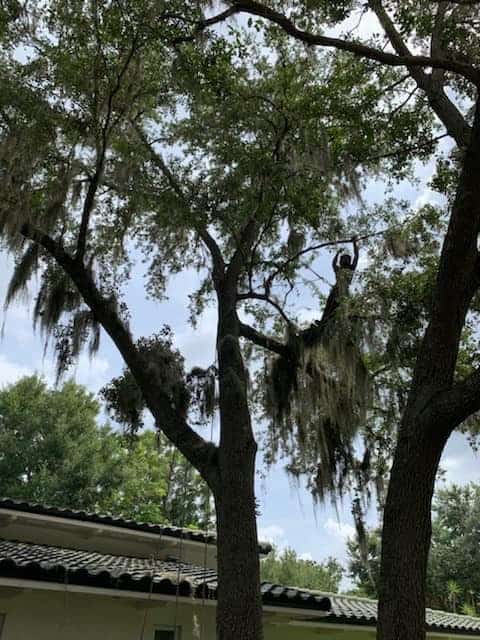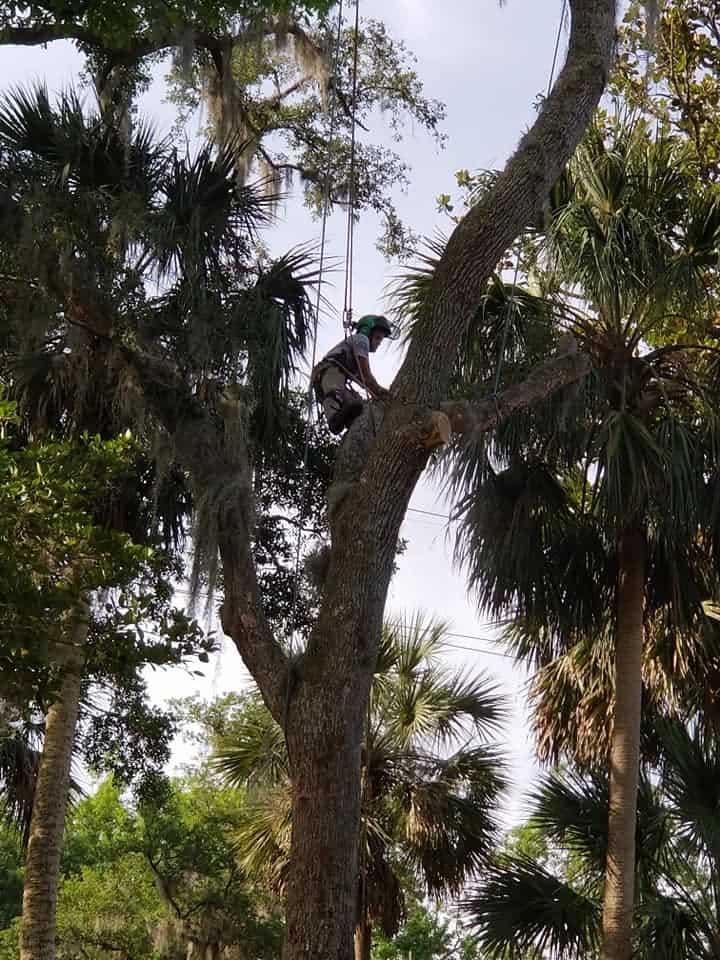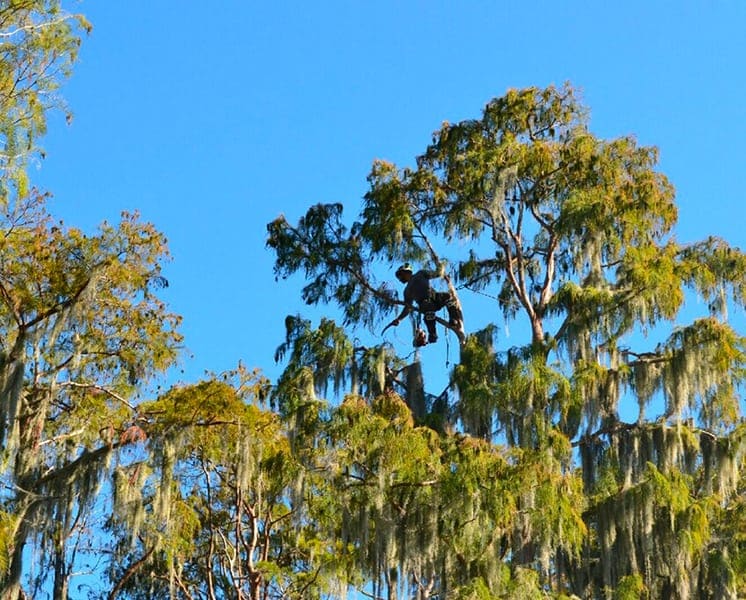By: Shelby McCullough| Published: January 10, 2024
Here at McCullough Tree Service, we believe that trimming willow trees is not only about maintaining their beauty but also about ensuring their health and growth. Willow trees are known for their resilience and robust vitality, which can be well-managed with strategic pruning. We often remind our readers and clients that late winter is the optimal period for willow tree maintenance due to its advantages in terms of visibility and decreased stress on the trees.

Join us as we delve deeper into this subject, sharing techniques and insights garnered from years of experience as professional willow tree trimmers. Our goal is to help you sustain the elegance and growth of your willow trees, season after season.
Key Takeaways
- Strategic pruning supports willow tree health and growth.
- Dead, diseased, and damaged branches should be promptly identified and removed during trimming.
- Willow tree maintenance is optimal during late winter.
- Regular pruning is necessary to manage the rapid growth and sprawling form of willow trees.
- Professional willow tree trimmers can provide expert advice and services to ensure your trees flourish.
Understanding Willow Tree Growth and Pruning Necessities
Willows, with their drooping branches and delicate leaves, adorn many landscapes with their unique beauty. However, beneath this attractive facade lies an intriguing cycle of rapid growth and inherent challenges that call for meticulous care and regular trimming. Understanding the dynamics of willow tree growth is key to grasping why appropriate pruning is necessary, its long term effects if neglected, and how to identify when trimming is due.
Characteristics of Willow Trees and Their Rapid Growth
Known for their extraordinary adaptability, willow trees thrive in the northern hemisphere, particularly near water sources and in moist soil. These trees can exhibit a startling growth rate of up to 10 feet per year, urging regular trimming to control their sprawling form. It’s this capacity for rapid growth, coupled with the tree’s resilience in cold climates, that makes the willow a fascinating study in arboreal resilience and vigor.
Long-Term Effects of Neglecting Pruning
While willows are notable for their robust vitality, neglecting regular pruning can lead them to become unruly. Such negligence not only compromises their aesthetics but also poses potential health risks. Branches left to multiply unchecked can, over time, create a breeding ground for diseases and invite physical damage from overcrowding. Besides, the unbridled growth of branches may interfere with the structural integrity of the tree, leading to issues with stability.
Recognizing the Signs for Pruning Willow Trees
For those keen on maintaining the growth and aesthetics of a willow tree, it’s important to learn to recognize the signs that indicate when pruning is due. These signs cover an array of factors, from detecting weakness or disease in branches, to identifying those that crisscross or rub against each other. Regular observation of your willow tree is therefore not just a pastime but an essential part of maintaining their charm and longevity.
Preparing for Pruning: Tools and Safety
When it comes to willow tree maintenance, selecting the right tools for trimming willow trees is a critical step. The nature of your tools can dictate the effectiveness of your pruning efforts, making them an essential aspect to consider.
Selecting the Right Pruning Tools for the Job
Different sizes and conditions of branches require various types of tools. For small branches up to 3/4 inch diameter, simple pruning shears work best. However, for branches that are slightly larger, up to 2 inches in diameter, loppers should be employed. For really large branches encroaching the diameter of 2 inches or more, a handsaw or pruning saw becomes essential. Gloves and safety glasses are a must to ensure personal safety during the pruning process.

For those branches that are hard to reach, a ladder or a pole pruner may be required. These handy instruments let you reach high branches without risking an unstable climb.
Note that professional willow tree trimmers often come equipped with more advanced tools like powered chainsaws, pole saws, and even lifts for very tall trees. However, for the average homeowner, manual tools suffice for effective willow tree trimming on their property.
Importance of Sanitizing Equipment to Prevent Disease
Beyond selecting the right tools, proper sanitation practices are equally important to avoid the introduction and spread of infections. A common mistake is to disregard the cleanliness of the tools employed for pruning. Sanitizing your pruning tools is not only a measure of good hygiene but also a crucial preventive measure against diseases like Willow blight or Willow scab, which could have severe impacts on the wellbeing of the willow trees.
Using rubbing alcohol to clean all your gear after every use is vital, and even between different trees to stop disease spread, this applies to all tools including pruning shears, loppers, handsaws, pruning saws and pole pruners. Not taking this step seriously might harm the tree you’re trying to help.
With the right tools in hand and proper sanitation practices, you’re well-prepared for effective willow tree trimming. The next sections dive deeper into the techniques and specifics of the pruning process, so stay tuned!
Guidelines for Trimming Willow Trees
Every person interested in willow tree maintenance often wonders: how to properly trim willow trees? To ensure healthy growth and keep your willow tree looking its best, it’s vital to follow specific techniques tailored for trimming willow trees.
The first step is the removal of any dead or damaged branches. It is crucial to cut these branches at their junctions with the trunk. By doing this, you instigate the tree’s natural healing mechanisms, reducing the risk of disease and infection. To do this effectively, always make sure your pruning equipment is sharp and clean
Once you have addressed the dead and damaged branches, you might notice some branches crisscrossing or rubbing against each other. These intertwined branches restrict air circulation and must be untangled. It’s always best to start from small branches and gradually proceed to larger ones.
- Step 1: Remove dead or damaged branches.
- Step 2: Eliminate competing stems to establish a strong central leader.
- Step 3: Untangle intertwined branches for better air circulation.
- Step 4: Prune lower branches to maintain the tree’s aesthetics.
The next step involves establishing a strong central leader. If you see stems competing with the main stem for dominance, they must be eliminated. While this may seem aggressive, it’s important to remember that this approach helps guide the tree’s overall growth and aesthetics.

In conclusion, practicing these techniques for trimming willow trees will help maintain your tree’s health and aesthetics. Remember to trim during the dormant season and always sanitize your tools before and after pruning. Care should be taken to avoid excessive pruning, which could lead to structural weaknesses and an increased risk of disease. By integrating these practices into your annual willow tree maintenance, you can enjoy the beauty of a well-kept, healthy willow for years to come.
Best Practices for Young Willow Tree Pruning
Pruning is not merely about limiting growth, but rather strategically promoting its essential form and vigor. Particularly when it comes to young willow tree pruning, it’s critical to employ a distinct approach, one that establishes a strong, structural foundation that will be essential for future growth. Our guide outlines some optimal techniques for trimming willow trees when they’re in their young, more impressionable stage.
Establishing a Strong Central Leader for Future Growth
Initiating the formative process, it’s essential to select a tall and vigorous central leader. This acts as the main trunk from which other branches grow out, thereby setting up the structure of the tree. Aim to cultivate this central leader, ensuring it grows upwards rather than allowing lateral branches to overshadow it. Such management solution aids in preventing breakage down the road and is a vital step in willow tree trimming.
Identifying and Trimming Competing Branches in Young Trees
As the willow tree grows, keep a keen eye on the branches that could compete with your chosen central leader. Identify these early and trim to keep the leader dominant. This selection and trimming process is fundamental in young willow tree pruning and in overall tree structure. As the tree matures, the focus of pruning should be to create a balanced distribution of branches around the tree. This includes the gradual removal of lower branches as the trunk reaches an adequate diameter – typically around 2 inches. Remember, this formative shaping approach is key to having a resilient willow tree in its mature stage.
Trimming a young willow tree requires a certain level of understanding of the tree’s natural structure and an aptitude in pruning strategy, but the result is well worth it. A well-trimmed and trained young willow promises to grow into a beautiful and resilient mature tree.
The Best Time to Trim Willow Trees
When it comes to perfecting the art of willow tree maintenance, timing is everything. The health and vitality of our trees can rely heavily on when we choose to pick up the pruning shears. Let’s delve into the ideal timeframe for trimming willow trees and the benefits it can bring to our beloved green giants.
Advantages of Winter Pruning for Willows
The best time to trim willow trees is during the winter months. Unlike deciduous trees that shed their leaves in the fall, willow trees enter dormancy in the winter, pausing their active growth. One of the primary advantages of winter pruning is that the tree is more able to readily heal when spring arrives, without the loss of vital sap that can occur during the growing season.
How to Prune a Twisted Willow Tree in Dormancy
For twisted willow trees, a specific pruning timetable is even more critical. Targeting late winter or early spring for pruning not only helps to prevent sap loss but also ensures cleaner cuts. The overall result? A healthier tree, ready to flourish come spring, less vulnerable to disease, and displaying a more manageable, aesthetically pleasing structure.
Pruning during dormancy allows us to focus on improving the tree’s form and structure without the distraction of leaves. It also reduces the likelihood of fungal infections that can cause considerable harm to willows.

So, there you have it. Whether you’re nurturing a twisted willow or looking after a weeping variety, remember that timing is crucial. When planned right, your willow tree trimming endeavors can lead to a tree that’s thriving, resilient, and ready to greet the onset of spring with vigor and vitality.
Pruning Mature Willow Trees for Health and Aesthetics
Willow trees, with their captivating charm, demand regular maintenance to secure their vibrant health and continue adding aesthetic value to landscapes. As they mature, the focus of willow tree maintenance subtly shifts from intense shaping to preserving health and promoting continuous growth. Our guide centers on the essential techniques of mature willow tree pruning to empower you with practical knowledge for taking care of these beautiful trees.
Essential Maintenance Tips for Mature Willow Trees
Mature willows require a lighter touch compared to their younger counterparts. The prime objective of trimming willow trees at this stage is to remove any broken or compromised branches. This approach facilitates quicker healing and deters disease. Nature has given Willows the strength to withstand significant shaping in their early years, but trying to drastically change a mature tree’s form can lead to weak structures and increased susceptibility to pests and diseases.
Techniques to Encourage Strong Structure and Reduce Disease
To maintain a robust and visually pleasing tree, pruning should be strategic and considerate of the tree’s growth. Identifying any potential issues promptly is an integral part of willow tree maintenance. Make neat cuts close to leaf buds or just above twigs to encourage swift healing over the wounds. Additionally, ensure routine removal of dead material, and diligently disinfect cuts to preclude any potential disease threats. Remember, when it comes to managing mature trees, following the principles of how to trim willow trees can make the difference between a lush, thriving tree and a struggling one.
Advancing Growth: Techniques for Trimming Willow Trees
Bringing the best out of your willow tree requires regular care and unique tree-specific techniques. Besides providing it with essential water and nutrients, one of the most important ways to ensure healthy growth is proper trimming. Not only does regular pruning help a willow tree maintain an appealing shape, it’s also vital for its health and vitality. Through strategic trimming techniques for willow trees, we can preserve their characteristic elegance and robust growth.
Crafting an Ideal Shape for Aesthetic Appeal and Tree Health
One of the major benefits of trimming willow trees is that it allows you to shape your tree just the way you want. The visual appeal of a well-pruned tree enhances its surrounding landscape, adding a striking touch of nature to the scenery. More importantly, trimming provides the tree with a boost to its health. By removing the right branches, you help the tree conserve its resources and reduce the risk of fallen branches and potential diseases linked with overgrown and stale portions.
Targeted Branch Removal to Promote Vigorous Growth
Understanding willow trees’ unique growth patterns can inform your pruning strategy. Given their notable vertical and lateral expansion, targeted branch removal is a key technique to enhance vigorous and healthy growth. By selectively pruning branches, you dictate the direction of new growth, shaping the tree to your liking, and promoting robust tree health. Remember, precision and timing are integral for getting the most out of your willow tree trimming endeavors.
Maintaining Willow Tree Health Post-Pruning
In the wake of the trimming process, it is crucial that we delve into necessary post-pruning care, a pivotal component of willow tree maintenance. Through diligent follow-up care, we can effectively promote the health and growth of our willows, harnessing the benefits of trimming willow trees.
Effective Debris Management to Minimize Disease Risk
Our initial task lies in executing effective debris management. This incorporates the swift disposal of all cut material left from the pruning process. By providing timely removal, we lower the risk of diseases and pest infestations. Furthermore, we aid in protective measures by applying a pruning sealant to larger cuts, which accelerates healing and safeguards exposed areas.
Nourishing the Tree: Watering and Fertilizing After Pruning
The nourishment of the willow tree plays a significant role in its health post-pruning. A consistent watering regime is especially beneficial in promoting new growth. The addition of fertilizer stands to further fortify the tree’s vitality, aiding in its recuperation following the pruning process.

Observing the tree’s progress is of utmost importance – we are looking for signs of vibrant new growth, which is a concrete indicator of successful trimming efforts. By implementing these techniques for trimming willow trees and following-up with a well-rounded maintenance regimen, we can create a thriving environment for our willows to grow and flourish.
At McCullough Tree Service, we are dedicated to providing exceptional tree services in Oakland, FL. Contact us now to start enhancing your landscape with our expert tree care solutions.
FAQs
1. When is the best time to trim my willow tree?
The ideal time to trim willow trees is during their dormant season in late winter. This reduces stress on the tree and helps promote healthier growth.
2. How much can I trim without damaging my willow tree?
It’s best to remove no more than 25% of the tree’s canopy in a single session to prevent stress and ensure the tree remains strong and healthy.
3. What tools should I use to trim my willow tree?
Use sharp pruning shears for small branches, loppers for medium-sized branches, and a pruning saw for larger limbs to make clean cuts and avoid damage.
4. Can I handle trimming my willow tree myself?
Small branches can be pruned by homeowners, but larger limbs or difficult cuts are best handled by a professional to ensure safety and proper technique.
5. How can I tell if a branch needs to be trimmed?
Trim branches that are dead, diseased, or growing inwards. Also, remove those interfering with the tree’s shape or growing too close to structures.

